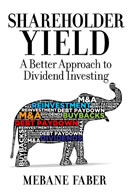 I’ve read a few books about dividend investing and remain interested in the idea, although I’m not confident enough (yet?) to allocate my portfolio that way. Portfolio manager and writer Mebane Faber has a short book called Shareholder Yield: A Better Approach to Dividend Investing that offers another tweak on dividend investing strategy.
I’ve read a few books about dividend investing and remain interested in the idea, although I’m not confident enough (yet?) to allocate my portfolio that way. Portfolio manager and writer Mebane Faber has a short book called Shareholder Yield: A Better Approach to Dividend Investing that offers another tweak on dividend investing strategy.
The book starts with an overview of history and academic research. First, a little over half the total return of the US stock market since 1871 is due to dividends. The smaller half is price appreciation, which when people talk about the S&P 500 index is all price appreciation. Second, stocks with higher dividends have had a higher historical return than stocks with little or no dividends.
So dividends are good, but they aren’t the entire picture. There are five ways for management to deploy the free cash flow generated by the company:
- Invest in existing operations,
- Acquire other businesses,
- Pay down debt,
- Repurchase stock (reducing outstanding shares), and
- Distribute cash to shareholders.
Now, a growing company should be investing their cash with #1 or #2, but only when they are very confident the return of incremental capital will be greater that their current return on capital. But back to dividends. In the book, Faber argues that due to income tax rates and other internal factors, an investor should also consider the actions of buying back shares and reducing debt to also be positive actions. Together with dividend yield, #3, #4, and #5 combine to create shareholder yield:
Shareholder Yield = Dividend Yield + Net Buyback Yield + Net Debt Paydown Yield.
A problem noted by some reviewers is that there is no good free tool for the DIY investor to screen for this specific metric. Stock buybacks are volatile in nature; there could a lot one year and then none the next. Not coincidentally, Faber is co-founder of Cambria Investment Partners, which in May 2013 introduced an actively-managed ETF called the Cambria Shareholder Yield ETF (ticker SYLD) that invests in companies with the highest shareholder yields. SYLD will do the work for you, at an expense ratio of 0.59%.
The ETF doesn’t really interest me at that price, but the idea of taking into account these other ways that cashflow can more directly increase shareholder value seems to have some merit. A company could be paying out dividends, but simultaneously issuing more shares and thus diluting shareholder value. Alternatively, if a company elects to use its cash flow to pay down debt, that would also seem to benefit the company over the long-term as much as distributing a dividend.
Concise book, good references and information, strategy hard to actually implement.
More coverage: ETFdb, Abnormal Returns
 The Best Credit Card Bonus Offers – 2025
The Best Credit Card Bonus Offers – 2025 Big List of Free Stocks from Brokerage Apps
Big List of Free Stocks from Brokerage Apps Best Interest Rates on Cash - 2025
Best Interest Rates on Cash - 2025 Free Credit Scores x 3 + Free Credit Monitoring
Free Credit Scores x 3 + Free Credit Monitoring Best No Fee 0% APR Balance Transfer Offers
Best No Fee 0% APR Balance Transfer Offers Little-Known Cellular Data Plans That Can Save Big Money
Little-Known Cellular Data Plans That Can Save Big Money How To Haggle Your Cable or Direct TV Bill
How To Haggle Your Cable or Direct TV Bill Big List of Free Consumer Data Reports (Credit, Rent, Work)
Big List of Free Consumer Data Reports (Credit, Rent, Work)
Interesting, grabbed the book for free, cheers.
I am tired chasing various strategies: I just invest into the entire world proportionally (VTI and VXUS) and let the dice fall.
There is a huge problem with her strategy. Debt can be used to create leverage which can increase shareholder returns. Optimal capital allocation rarely involves zero debt.
First, Companies that are growing fast often finance growth with debt. Second, companies often finance share buy backs and dividends with debt.
Have you read the Single Best Investment book? It is a pretty good book about dividend growth investing. It is the growth what makes the dividend investing so powerful compared to other strategies. For example JNJ. After 10 years your YOC will be close to 20% and that is very impressive result, don’t you think? I try to read about dividend investing as much as I can and as many books I read as confident I am that this is the right strategy. (of course having a few growth stocks is fine, but not as a core of my portfolio.).